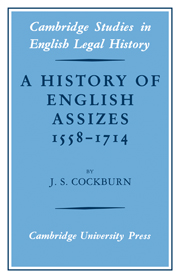INTRODUCTION
Published online by Cambridge University Press: 07 October 2011
Summary
Assizes in their modern emasculated form retain little of that prestige and omnipotence with which they were long associated. No longer are itinerant justices compared in popular metaphor to visiting bishops, circling planets, or the streams of paradise. True, in the ceremonial opening of assizes –the police and militia units, splendid dignitaries, the time-hallowed formulae–it is possible even today to glimpse something of the awed respect anciently accorded to the judges of assize. But the administrative and political power by which they for centuries commanded the respect of provincial society has long since been assumed by less majestic institutions, and it is impossible to recognize in today's exclusively judicial tribunal the potent executive instrument of the sixteenth and seventeenth centuries. Criticism of the judicial utility of assizes is a relatively recent phenomenon. But since surrendering its prestige in the late seventeenth and its governmental functions early in the eighteenth century the system has, as it were, resembled a lamb in wolf's clothing. In this sense assize courts have been living on their reputation for two centuries, and recent moves to streamline the system in the light of changed circumstances and the interests of economy come as little surprise.
During its long history, however, the court of assize has served many purposes, not all of them universally beneficial, some perhaps unintended. Initially the central courts themselves welcomed a system which promised relief from an increasing burden of litigation.
- Type
- Chapter
- Information
- A History of English Assizes 1558–1714 , pp. 1 - 12Publisher: Cambridge University PressPrint publication year: 1972

